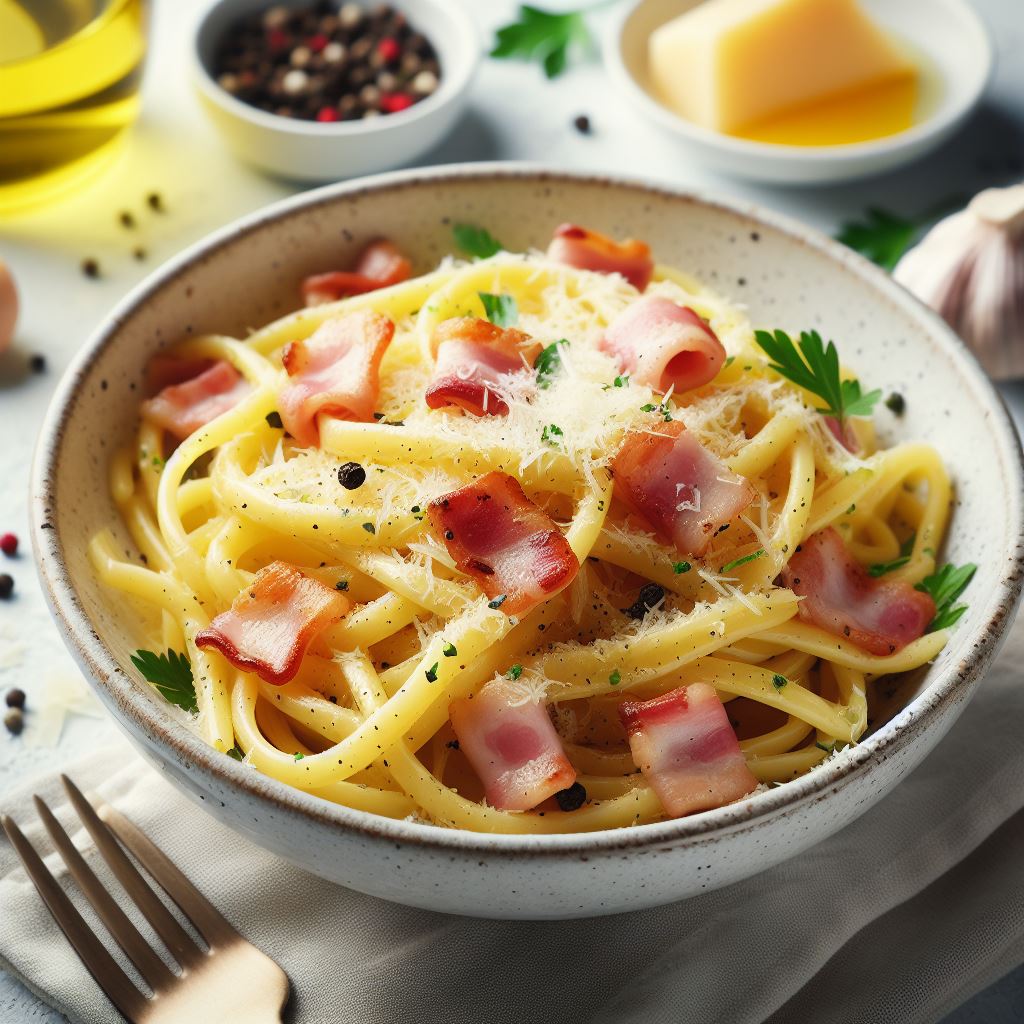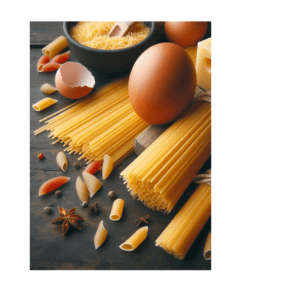
The classic carbonara, who would have thought that such lovely simple pasta dish could create so much impassioned debate over its origins and how it should be made and where and when it originated. Leave it to the Romans for all the discourse and exchange of views over who is right about eggs, bacon and cheese.
What is pasta carbonara? Let’s explore its history and find its origins. Some stories might be true and some might seem more questionable. We can explore how the dish should be prepared, or how the purists claim it should be prepared and other versions, some accepted and some disdained by the critics. I’ll share a traditional purist’s carbonara recipe, and a personal story.
Carbonara and WWII
Was it a WWII dish for American soldiers? There are no traces of Carbonara prior to the liberation of Rome in 1944, nothing appears on carbonara until the mid 20th century. Here is a very plausible theory for the beginning of pasta carbonara. That being, American soldiers would bring their rations of bacon, and powdered eggs to the local restaurants where they would prepare the bacon and powdered eggs and make a sauce to be tossed in with spaghetti. Later pasta carbonara would become a dish enjoyed by Italians and revised with the use of guanciale or pancetta.
So carbonara may have been born after World War II and it was after the war that this dish appeared in cookbooks and newspapers like La Stampa and the magazine ‘La Cucina Italiana’. Then in 1954 a British chef, Elizabeth David, wrote a cookbook ‘Italian Food’. She had written extensively on Mediterranean food and cooking. This was the dawn of the basic traditional carbonara recipe. In David’s book she suggests using ham or coppa, Italian cured pork shoulder, which would be cut into short strips, instead of the American soldiers use of bacon. Was it the beginning of something new? Carbonara was definitely an Italian dish even if it wasn’t totally invented by Italians.
Interestingly, the first carbonara recipe was published in the US in 1952, It was a food guide written by Patricia Bronte, who is best known for writing stories that are centered around food-related crimes, such as poisoning and theft. Her guide ‘Vittles and Vice: An Extraordinary guide to What’s Cooking on Chicago’s Near North Side’, Tells of stories and food of Chicago’s Near North Side and after reviewing Armando’s Restaurant she added their recipe to its pages
Pasta Carbonara a dish for poor workers
Carbonara is also know as “coal miner’s spaghetti”. This version may be part folklore, and part historically accurate. Rather than a dish originating specifically in Rome, the capital of the Lazio region, pasta carbonara was a popular dish of poor coal miners of the Lazio region.
They had to bring their food with them, as they had to stay away from home for long periods of time to tend to the coal. This food had to last so preservation was important as well inexpensive and could not require refrigeration. They carried simple staples like pasta, eggs, cheese, salt pork, or bacon in baskets or a haversack, a type of shoulder bag. The coal miners shared this warm hearty meal that they cooked over their hot coals or wood fires.
The Carbonaria a Secret Society and their Secret Dish
According to this story from the 19th century pasta carbonara originated sometime during the early part of the century when a secret society called The Carbonaria existed. This secret society came about after the defeat of Napoleon in 1815 because they fought for liberal ideals, they had to hide or possibly be killed off. In hiding they had to acquire simple food sources to survive. So with these easily accessible ingredients eggs, bacon, pasta and cheese, pasta carbonara may have found it’s early beginnings.
How the Purists Have Come to Make Carbonara and Other Versions
According to the canonical law of preparing pasta carbonara today, the purists defend its ingredients to the bitter end. There are 5 main ingredients.
- Pasta-spaghetti or rigatoni
- Pecorino cheese
- Guanciale
- Eggs
- Pepper

Somewhere along the way the purists have caused political debate over this dish, sort of harsh considering there was no recorded recipe until the end of the 19th century. The debate was probably occurring because the purists were refusing to accept the coming pasta revolution that surrounds us today.
How to Prepare Pasta Carbonara-This is probably the most traditional preparation and possibly the purist’s version.
Tip: To make the dish go easy on the salt the guanciale and Pecorino cheese are already salty.
Preparation:
- In a pan you want to add pieces of guanciale, about 1/4″ thick and cook it on a low flame so it doesn’t burn. Let it cook for 8-10 minutes or until crispy not burnt. Drain some fat but save most of it.
- As for the pasta make sure to cook the pasta el dente, follow the cooking instructions on the box. I like to stop cooking the pasta one minute under the time required as it will continue to cook while you prepare the rest of it. You’ll want to save some hot pasta water to add when blending in the egg and cheese into the pasta. When the pasta is done, remove it from the stove and add it into the pan with the crispy guanciale.
- While your pasta is cooking blend together your eggs and Pecorino cheese. I like to separate the egg yolk from the whites. Keep in mind you’ll add some the egg whites back in depending on how creamy you like it or you can use only egg yolk if you don’t want it creamy but drier, the more whites you use the creamier it will become.
- Add your cheese and egg into your pan with the pasta and guanciale along with a splash of pasta water making sure the pan is not too hot so the egg doesn’t start cooking, stir the pasta and slowly add in your egg whites stirring until it’s as creamy as you want. Be careful you can always add more egg whites if you want it creamier. Add pepper and toss to mix, I like a lot of pepper. Top it with a spoonful or more of Percorino, eat and enjoy!
There are many other versions that wouldn’t hold up in a carbonara court room, here are a few.
Instead of using any type of bacon make it vegetarian and add broccoli or other vegetables of your choice .
Pasta carbonara made with garlic or cream is a big no no but, yet again, go ahead, when cooking the guanciale add some garlic and when mixing the eggs and Pecorino add a bit of cream. I’m sure this version might be delicious too. Then there are versions that use only Parmigiano cheese or Pecorino when cooking and Parmigiano again at the end.
There are seafood versions, instead of the bacon or guanciale add smoked fish, maybe bortagga, sauteed shrimp, wild tuna, there are many seafood additions that can be tried.
We can’t forget Carbonaragate, when the French decided to make carbonara into a one pot meal using bow ties, and topping it with crème fraiche, but the Italians can’t stop the pasta revolution that’s been happening now for many years. Either way there will be many versions of this simple dish.
As a young woman just moving to NYC I was invited to a co-worker’s home for a pasta dinner. Never having pasta carbonara I was delighted to try something entirely new to me. This was many years ago, probably around 1985 or 1986 and pasta carbonara hadn’t yet made its way to becoming the popular American dish that it is today. My co-worker had moved from Vietnam to Puligia, Italy as a teenager and lived there for many years. There he leaned how to prepare many Italian dishes and became quite the cook. Upon moving to the US he brought his remarkable Italian and Vietnamese cooking skills to his new American lifestyle and would have guests come often for dinner.
I had the most wonderful dinner that night and not knowing what carbonara was, I now tasted a great new dish. I thought this ingenious, so not knowing where to get guanciale or pancetta, he cleverly used Asian hot sausage. which he enjoyed using regularly. This was such a quirky ingredient, I found humor in it, no matter it was so delicious. All the other ingredients were the typical ingredients, pasta, eggs, and Pecorino cheese. It was prepared in the traditional manner except for the Asian hot sausage. Not that I knew how it should taste with guanciale or pancetta, I would have to say this unusual ingredient made a fabulous carbonara and a wonderful meal for me and for all his other guests that evening.
Wherever the Origin or whatever the Version May Be
There are many stories as to Carbonara’s origins and many versions on how to prepare it, that most probably would enjoy and then you have the purists, very strict on its preparation and nothing else, so okay it is just pasta!
In general, I’d like to say that I think the likely hood of the American soldiers after WWII with their rations really helped to bring the dish to its popularity in Italy. This seems like such a genuine path to putting pasta carbonara finally on record.
If you haven’t had pasta carbonara and enjoy cooking, try the recipe I suggest or explore other versions and find out what you like, and If you already love it, wonderful, eat some more! As well, to all of you who’ve read this post you can explore more stories on where the dish began, I’m sure you’ll find other hypotheses on its beginnings and enjoy other versions. If I’m craving carbonara as I often do, I’ll use bacon if I don’t have guanciale on hand. Heck, I’d even use the Asian hot sausage and whether you are skipping the guanciale and opting for vegetables, regular bacon, seafood, cream, with garlic or without, this pasta dish, after all, was always just about eggs, bacon and cheese but you can dress it up anyway you like. However, you like your pasta carbonara is really all that matters, afterall, you are the one eating it.
If you have any thoughts or questions I’d be happy to help, so please feel free to leave your comments below.
—
